Pasos, pride, passion and penitence in Orihuela for Semana Santa
The scent of incense, crackle of sweet wrappers and glow of lamplight accompanied the Good Friday procession in Orihuela
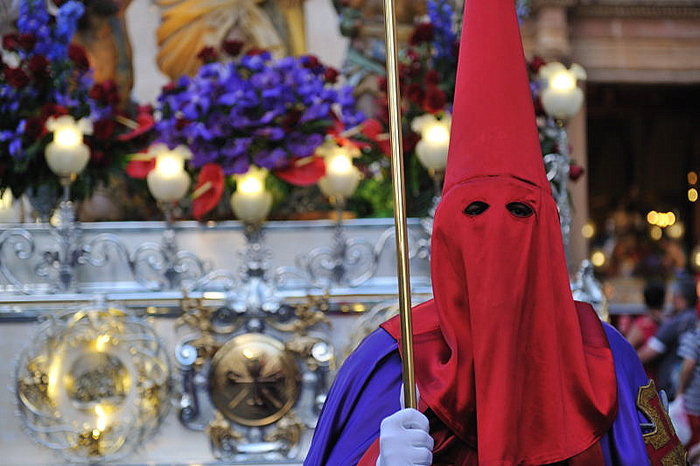
Semana Santa in Orihuela is recognised as being of International tourism interest, due mainly to its great age, and the historical religious presence within the city. Orihuela has an impressive collection of historical monuments, gothic towers and clocks, effusive baroque stonework and soaring mediaeval vaulted ceilings 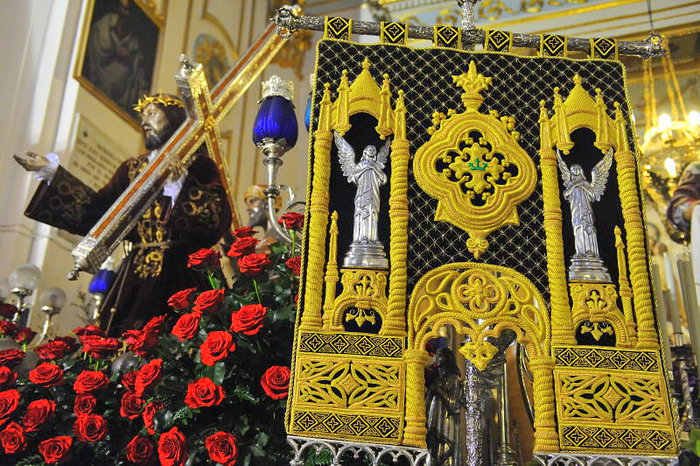 the perfect backdrop against which to view an extensive offering of flower decked baroque sculptures, lavishly embroidered standards and colourful capirotes.
the perfect backdrop against which to view an extensive offering of flower decked baroque sculptures, lavishly embroidered standards and colourful capirotes.
The origins of the Semana Santa in Orihuela, date back to 1536 and the Capilla del Loreto, which is located in Calle Mayor, alongside the Episcopal Palace. This was the headquarters for the first four recorded Cofradías, 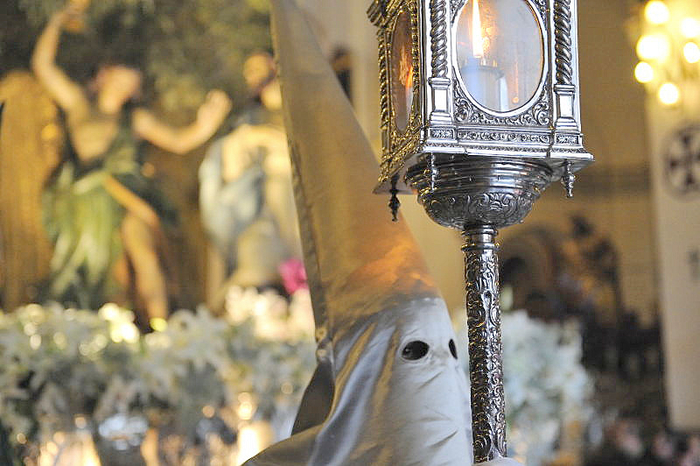 (brotherhoods) dedicated to the Santísimo Sacramento, Purísima Sangre de Cristo, Nuestra Señora del Loreto and Nuestra Señora de los Desamparados. Their róle was to provide the wax for candles consumed in the cathedral, which is opposite the palace, and also to bury the homeless and those who had been convicted by the courts. In order to undertake these services they ran a candle making factory
(brotherhoods) dedicated to the Santísimo Sacramento, Purísima Sangre de Cristo, Nuestra Señora del Loreto and Nuestra Señora de los Desamparados. Their róle was to provide the wax for candles consumed in the cathedral, which is opposite the palace, and also to bury the homeless and those who had been convicted by the courts. In order to undertake these services they ran a candle making factory 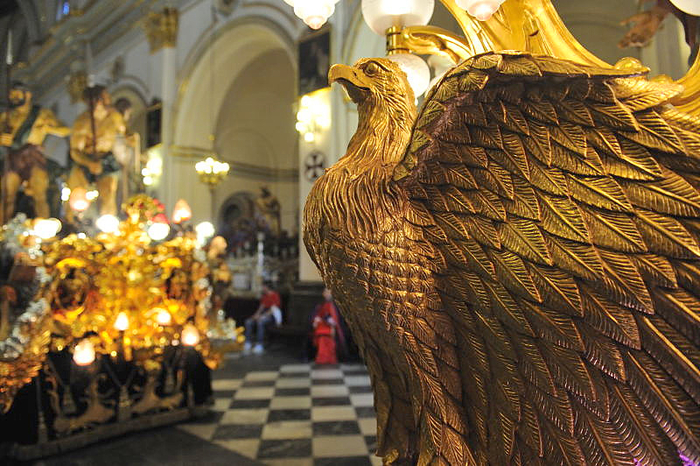 and asked for alms during a procession which took place on the eve of Good Friday.
and asked for alms during a procession which took place on the eve of Good Friday.
By the middle of the 17th century the numbers of participants had grown considerably along with the wealth and prestige of Orihuela itself, as more sculptures and Cofradías were added to the collection, including “La Diablesa”, ( the she-devil) probably the most famous sculpture in the collection, which parades on Saturday evening and is housed in the municipal archaeological museum throughout the year.
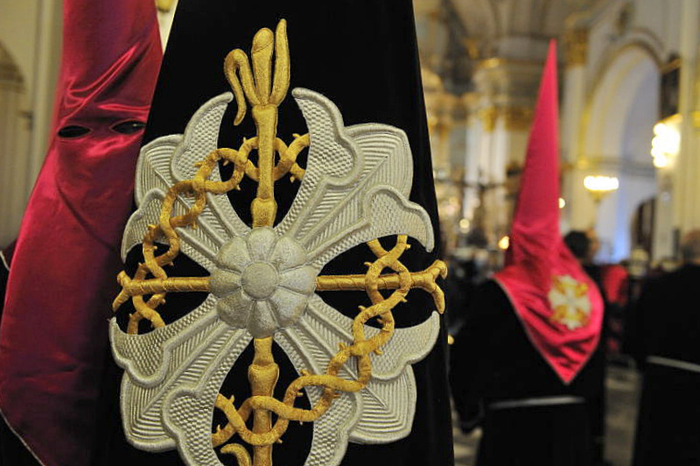 Semana Santa underwent a brief break during the War of Succession which resulted in many churches and sculptures being sacked or destroyed by troops, before the processions resumed and new Cofradías were formed in the middle of the 18th century ( Nuestra Señora de los Dolores and la Real Congregación de Nuestra Señora del Pilar contra el Pecado Mortal.) The latter began a new procession on
Semana Santa underwent a brief break during the War of Succession which resulted in many churches and sculptures being sacked or destroyed by troops, before the processions resumed and new Cofradías were formed in the middle of the 18th century ( Nuestra Señora de los Dolores and la Real Congregación de Nuestra Señora del Pilar contra el Pecado Mortal.) The latter began a new procession on 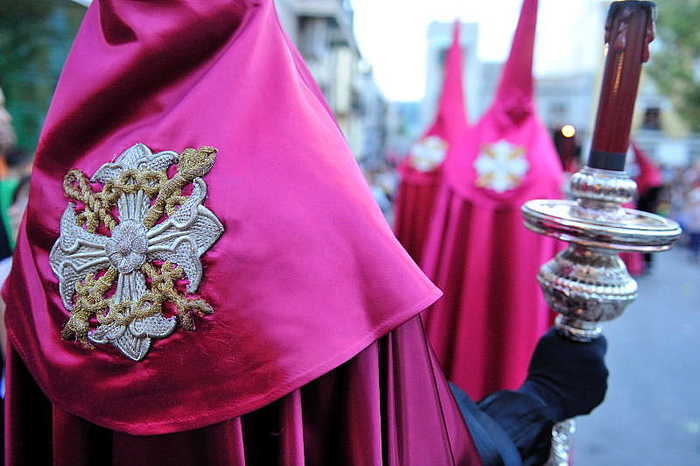 Holy Thursday, and as a royal order was the proud owner of seven important sculptures made by the most important baroque master of the era, Francisco Salzillo, who worked from Murcia and to whom a museum is dedicated in Murcia City. The procession became known as the procesión “de los Pasos de Cristo”( the procession of the sculptures of Christ.) By this point the procession had also acquired “armados
Holy Thursday, and as a royal order was the proud owner of seven important sculptures made by the most important baroque master of the era, Francisco Salzillo, who worked from Murcia and to whom a museum is dedicated in Murcia City. The procession became known as the procesión “de los Pasos de Cristo”( the procession of the sculptures of Christ.) By this point the procession had also acquired “armados 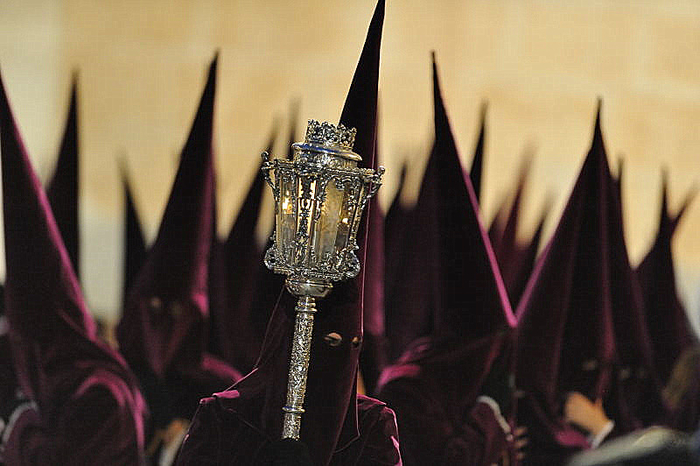 vestidos con yerros”, armoured Roman soldiers as well as trumpets and drums, all of which are still important features of the Orihuela Semana Santa today .
vestidos con yerros”, armoured Roman soldiers as well as trumpets and drums, all of which are still important features of the Orihuela Semana Santa today .
Moving into the 19th century another war once again halted proceedings, this time the War of Independence, following which the Orihuela Semana Santa began to really take on its modern day form, with the addition of processions on Palm Sunday, Tuesday, Wednesday, Thursday and Good Friday. However, in the 1930’s the Spanish Civil War wrought its havoc across Spain, thousands of sculptures destroyed and burnt, amongst them many of the precious Baroque pieces commissioned by the early Cofradías. Orihuela managed to 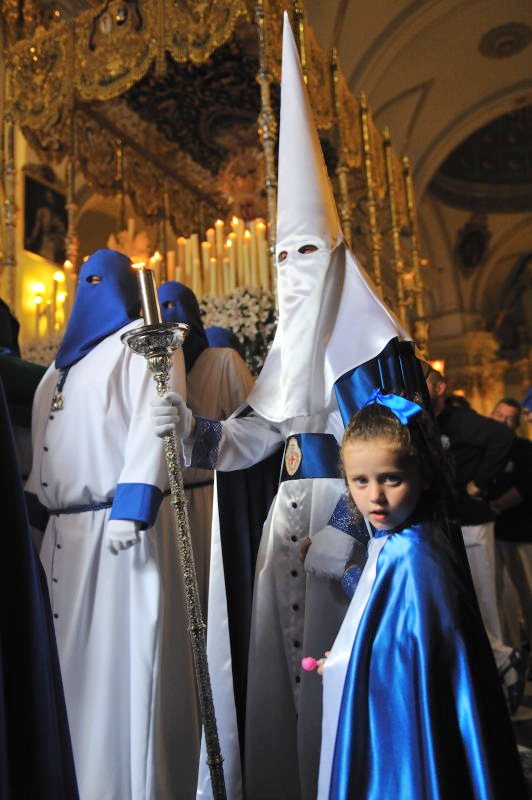 conserve some of its most important works by Salzillo, some of which paraded during the Good Friday night parade.
conserve some of its most important works by Salzillo, some of which paraded during the Good Friday night parade.
After the new era of Democracy began the Semana Santa celebrations in Orihuela gained a new impetus, the number of pasos and Cofradías increasing, along with the importance of this Semana Santa in Orihuela which was granted official status as being of International tourism interest.
The city has a museum dedicated to Semana Santa which houses the tronos on which the pasos( sculptures) are carried, along with some of the sculptures themselves, although many of these are housed in the churches of Orihuela throughout the year, but the best place to see them is during the processions when they are surrounded by flowers and light, accompanied by penitents in their vibrant robes and the processional marches and drums which are as much an element of this week as the smell of incense and roses in the streets.
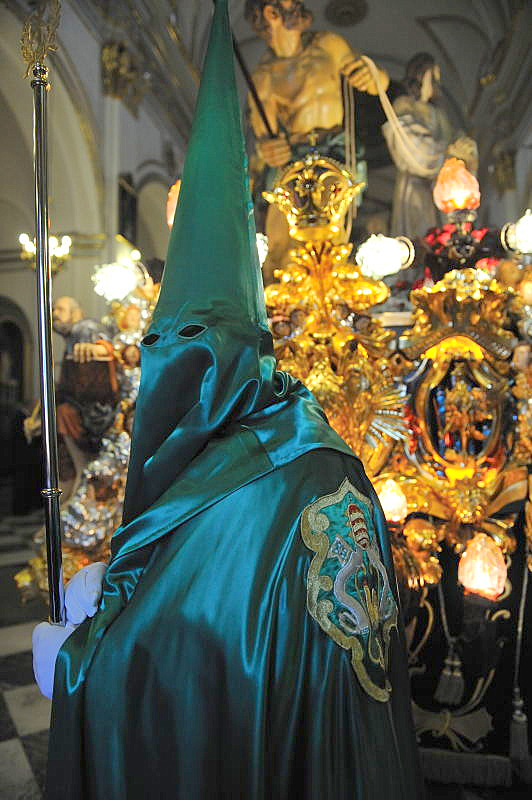 The Friday night procession is the largest of the week, featuring all of the main pasos and Cofradías, tracing the story of the last week in the life of Christ, from his triumphant entry into Jerusalem on a donkey on Palm Sunday to his betrayal, the denial of Peter and his crucifixion, and is probably the best parade of the week for those with little experience of Semana Santa to attend.
The Friday night procession is the largest of the week, featuring all of the main pasos and Cofradías, tracing the story of the last week in the life of Christ, from his triumphant entry into Jerusalem on a donkey on Palm Sunday to his betrayal, the denial of Peter and his crucifixion, and is probably the best parade of the week for those with little experience of Semana Santa to attend.
On Friday the pasos are all gathered together in the Santuario de Monserrate, where florists put the finishing touches to their floral decorations, trim the wax on their candles and prepare the tronos for the evening procession, the church open for the general public to see the magnificent details up close. The true beauty of Semana Santa is in the detail, each Cofradía having its own embroidered badge and standards, their staffs and torches bearing the same details, the tronos incorporating motifs which reflect the pasos they carry and the insignia of the cofradías. When the tronos are seen passing by in the parade there is so much to look at 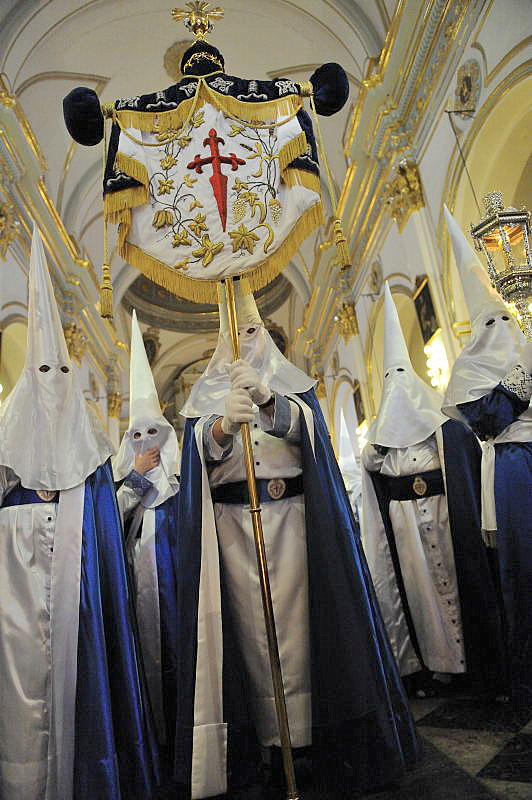 during a few swift seconds, but the luxury of being able to see the intricate details of curving handles dressed with scrolling acanthus and pierced silver detail, screaming open mouths of the damned or fleshy softness of plump cherubs, all up close and in remarkable detail is a real treat, and is also an excellent opportunity to admire the pasos leisurely inside the setting of the church.
during a few swift seconds, but the luxury of being able to see the intricate details of curving handles dressed with scrolling acanthus and pierced silver detail, screaming open mouths of the damned or fleshy softness of plump cherubs, all up close and in remarkable detail is a real treat, and is also an excellent opportunity to admire the pasos leisurely inside the setting of the church.
On the Thursday and Friday prior to this main procession the tourist office run a series of guided visits taking tourists inside the Semana Santa of Orihuela, explaining the little quirks and customs which are borne from 500 years of tradition and fervour, part of which includes a visit to see the work underway preparing the tronos for the procession.
It takes more than three hours for the pasos to file from the church of Monserrate, each of the huge structures carrying the pasos carefully manoeuvred inside the church to bring them just inside the main door before the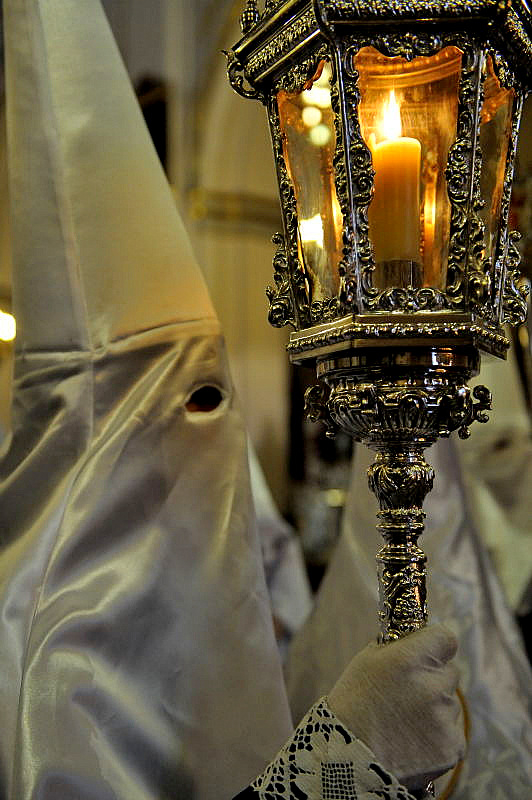 costaleros who will carry them around the streets lift them from their stands and undertake the delicate operation of negotiating the exit down the ramp and into the street, a difficult task as some of these structures are several metres high and only just fit through the arch of the door. Once in the street they are joined by their standard bearers and penitents, wearing the robes of their respective Cofradía, and tall pointed capirote hats, along with lanterns, bands and throngs of children doling out sweets to spectators.
costaleros who will carry them around the streets lift them from their stands and undertake the delicate operation of negotiating the exit down the ramp and into the street, a difficult task as some of these structures are several metres high and only just fit through the arch of the door. Once in the street they are joined by their standard bearers and penitents, wearing the robes of their respective Cofradía, and tall pointed capirote hats, along with lanterns, bands and throngs of children doling out sweets to spectators.
Spanish nationals come from across Spain to see this procession, renowned for its character, setting and pasos, but for foreigners the whole event is an extraordinary spectacle, a celebration of Easter on a grand scale, an event which draws families and communities to create a public display of faith and penitence, 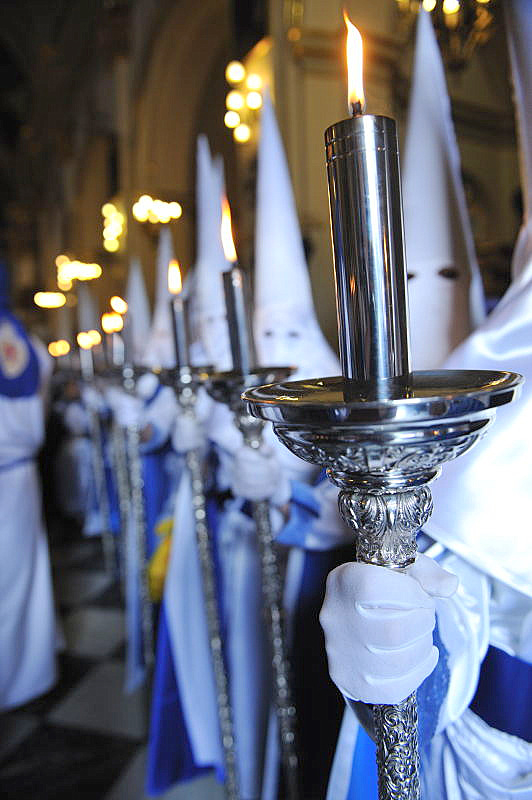 yet with unashamed pride in the ostentatious beauty of flowers, sculptural masterpieces, gold thread and pomp , a noisy and colourful demonstration of faith so at odds with the solemnity of our own more subdued religious practices, but one which is well worth the effort of experiencing should you be close enough to travel to Orihuela during Semana Santa.
yet with unashamed pride in the ostentatious beauty of flowers, sculptural masterpieces, gold thread and pomp , a noisy and colourful demonstration of faith so at odds with the solemnity of our own more subdued religious practices, but one which is well worth the effort of experiencing should you be close enough to travel to Orihuela during Semana Santa.

































